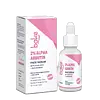What's inside
What's inside
 Key Ingredients
Key Ingredients

 Benefits
Benefits

 Concerns
Concerns

No concerns
 Ingredients Side-by-side
Ingredients Side-by-side

Water
Skin ConditioningTranexamic Acid
AstringentAlpha-Arbutin
AntioxidantPhenoxyethanol
PreservativeCitric Acid
BufferingSodium Hyaluronate
HumectantCaffeine
Skin ConditioningCeramide EOP
Skin ConditioningCeramide Ns
Skin ConditioningCeramide NP
Skin ConditioningCeramide As
Skin ConditioningCeramide AP
Skin ConditioningLaminaria Digitata Extract
Skin ProtectingCetyl-Pg Hydroxyethyl Palmitamide
Skin ConditioningAloe Barbadensis Leaf Extract
EmollientHydroxyethylcellulose
Emulsion StabilisingXanthan Gum
EmulsifyingPanthenol
Skin ConditioningSodium Metabisulfite
AntioxidantEthylhexylglycerin
Skin ConditioningSodium Gluconate
Skin ConditioningMaltodextrin
AbsorbentWater, Tranexamic Acid, Alpha-Arbutin, Phenoxyethanol, Citric Acid, Sodium Hyaluronate, Caffeine, Ceramide EOP, Ceramide Ns, Ceramide NP, Ceramide As, Ceramide AP, Laminaria Digitata Extract, Cetyl-Pg Hydroxyethyl Palmitamide, Aloe Barbadensis Leaf Extract, Hydroxyethylcellulose, Xanthan Gum, Panthenol, Sodium Metabisulfite, Ethylhexylglycerin, Sodium Gluconate, Maltodextrin
Ingredients Explained
These ingredients are found in both products.
Ingredients higher up in an ingredient list are typically present in a larger amount.
Alpha-Arbutin is made from hydroquinone and glucose. It may also be derived from the fermentation of soybeans.
This ingredient an antioxidant, meaning it helps protect your skin cells against damage.
Studies show this ingredient helps improve hyperpigmentation and fade discoloration.
Alpha-Arbutin may be used with other ingredients that help with hyperpigmentation. These ingredients include retinol, Vitamin C, niacinamide, and tranexamic acid.
Learn more about Alpha-ArbutinCitric Acid is an alpha hydroxy acid (AHA) naturally found in citrus fruits like oranges, lemons, and limes.
Like other AHAs, citric acid can exfoliate skin by breaking down the bonds that hold dead skin cells together. This helps reveal smoother and brighter skin underneath.
However, this exfoliating effect only happens at high concentrations (20%) which can be hard to find in cosmetic products.
Due to this, citric acid is usually included in small amounts as a pH adjuster. This helps keep products slightly more acidic and compatible with skin's natural pH.
In skincare formulas, citric acid can:
While it can provide some skin benefits, research shows lactic acid and glycolic acid are generally more effective and less irritating exfoliants.
Most citric acid used in skincare today is made by fermenting sugars (usually from molasses). This synthetic version is identical to the natural citrus form but easier to stabilize and use in formulations.
Read more about some other popular AHA's here:
Learn more about Citric Acid